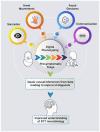The Newborn Screening Programme Revisited: An Expert Opinion on the Challenges of Rett Syndrome
- PMID: 39766837
- PMCID: PMC11675257
- DOI: 10.3390/genes15121570
The Newborn Screening Programme Revisited: An Expert Opinion on the Challenges of Rett Syndrome
Abstract
Genomic sequencing has the potential to revolutionise newborn screening (NBS) programmes. In 2024, Genomics England began to recruit for the Generation Study (GS), which uses whole genome sequencing (WGS) to detect genetic changes in 500 genes in more than 200 rare conditions. Ultimately, its purpose is to facilitate the earlier identification of rare conditions and thereby improve health-related outcomes for individuals. The adoption of rare conditions into the GS was guided by four criteria: (1) the gene causing the condition can be reliably detected; (2) if undiagnosed, the rare condition would have a serious impact; (3) early or presymptomatic testing would substantially improve outcomes; and (4) interventions for conditions screened are accessible to all. Rett syndrome (RTT, OMIM 312750), a paediatric neurodevelopment disorder, was not included in the list of rare conditions in the GS. In this opinion article, we revisit the GS and discuss RTT from the perspective of these four criteria. We begin with an introduction to the GS and then summarise key points about the four principles, presenting challenges and opportunities for individuals with RTT. We provide insight into how data could be collected during the presymptomatic phase, which could facilitate early diagnosis and improve our understanding of the prodromal stage of RTT. Although many features of RTT present a departure from criteria adopted by the GS, advances in RTT research, combined with advocacy from parent-based organisations, could facilitate its entry into future newborn screening programmes.
Keywords: Generation Study; Rett syndrome; digital phenotyping; newborn screening; presymptomatic testing.
Conflict of interest statement
P.S. is on the advisory board of Acadia Pharmaceuticals. P.S. was a past Principal Investigator (PI) on the Sarizotan (protocol number: Sarizotan/001/II/2015;
Figures

Similar articles
-
Technological Improvements in the Genetic Diagnosis of Rett Syndrome Spectrum Disorders.Int J Mol Sci. 2021 Sep 26;22(19):10375. doi: 10.3390/ijms221910375. Int J Mol Sci. 2021. PMID: 34638716 Free PMC article. Review.
-
Newborn screening and prenatal diagnosis for Rett syndrome: implications for therapy.J Child Neurol. 2005 Sep;20(9):779-83. doi: 10.1177/08830738050200091401. J Child Neurol. 2005. PMID: 16225835 Review.
-
Co-Creating the Experience of Consent for Newborn Genome Sequencing: The Generation Study.Public Health Genomics. 2024;27(1):210-227. doi: 10.1159/000541935. Epub 2024 Oct 11. Public Health Genomics. 2024. PMID: 39396502
-
The utility of Next Generation Sequencing for molecular diagnostics in Rett syndrome.Sci Rep. 2017 Sep 25;7(1):12288. doi: 10.1038/s41598-017-11620-3. Sci Rep. 2017. PMID: 28947817 Free PMC article.
-
Genomic and transcriptomic analyses distinguish classic Rett and Rett-like syndrome and reveals shared altered pathways.Genomics. 2011 Jan;97(1):19-28. doi: 10.1016/j.ygeno.2010.09.004. Epub 2010 Oct 8. Genomics. 2011. PMID: 20934504
Cited by
-
Molecular Insights into Neurological Regression with a Focus on Rett Syndrome-A Narrative Review.Int J Mol Sci. 2025 Jun 3;26(11):5361. doi: 10.3390/ijms26115361. Int J Mol Sci. 2025. PMID: 40508170 Free PMC article. Review.
References
-
- Green R.C., Shah N., Genetti C.A., Yu T., Zettler B., Uveges M.K., Ceyhan-Birsoy O., Lebo M.S., Pereira S., Agrawal P.B., et al. Actionability of unanticipated monogenic disease risks in newborn genomic screening: Findings from the BabySeq Project. Am. J. Hum. Genet. 2023;110:1034–1045. doi: 10.1016/j.ajhg.2023.05.007. - DOI - PMC - PubMed
MeSH terms
Grants and funding
LinkOut - more resources
Full Text Sources
Medical
Research Materials
Miscellaneous

